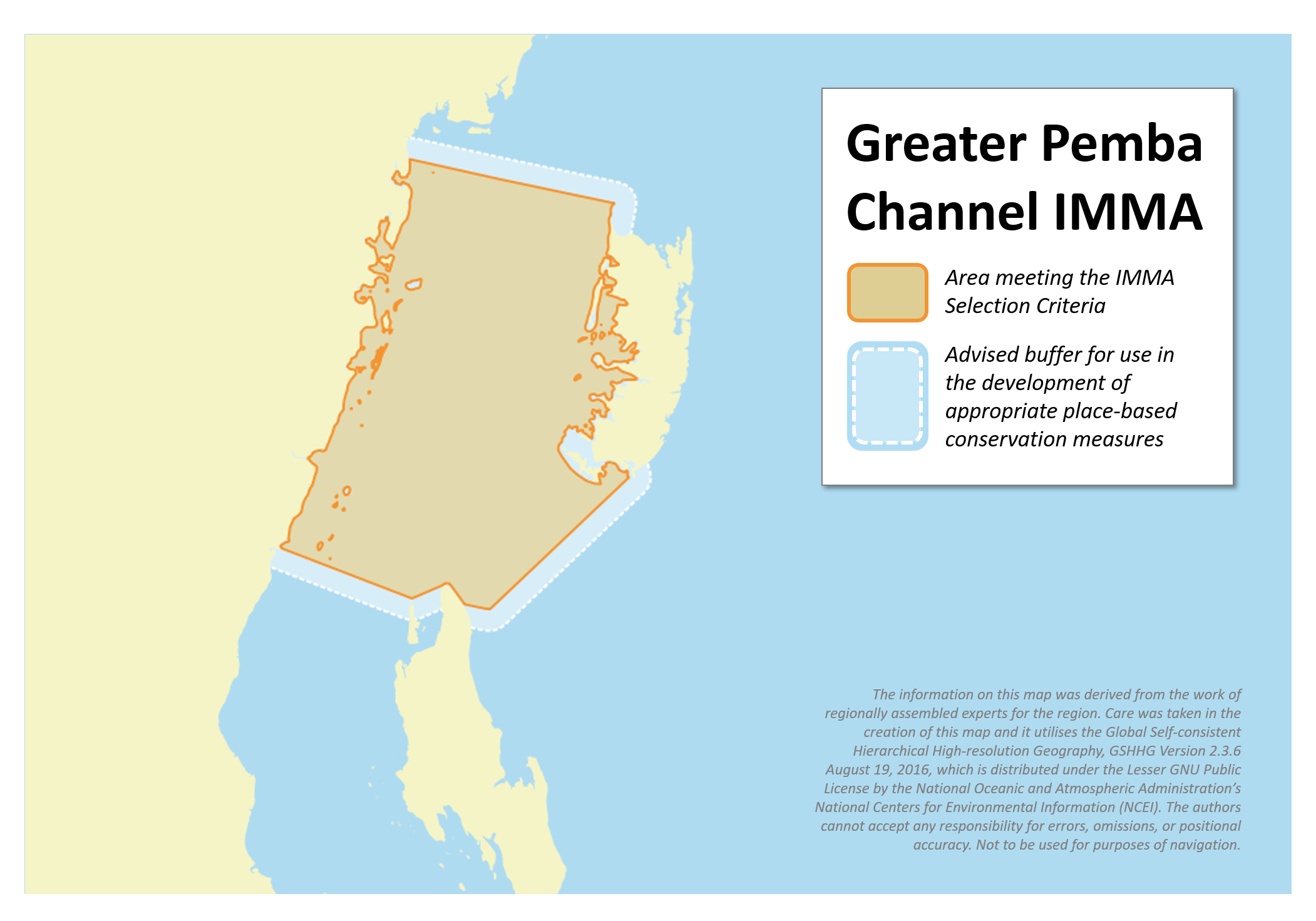Greater Pemba Channel IMMA
Size in Square Kilometres
6 647 km2
Qualifying Species and Criteria
Indo-Pacific Bottlenose dolphin – Tursiops aduncus
Criterion B (1)
Indian Ocean humpback dolphin – Sousa plumbea
Criterion A; B (1)
Marine Mammal Diversity
Criterion D (2)
Delphinus delphis tropicalis, Globicephala macrocephalus, Grampus griseus, Kogia breviceps, Lagenodelphis hosei, Megaptera novaeangliae, Mesoplodon densirostris, Pseudorca crassidens, Sousa plumbea, Stenella attenuata, Stenella longirostris, Tursiops aduncus, Tursiops truncatus
Download fact sheet
Summary
The Pemba Channel is located in northern Tanzania in the Western Indian Ocean. It is a 50 km wide, but 1000m deep channel that separates the island of Pemba from mainland Africa. The channel has steep bathymetry and a north flowing current that provides productive conditions for fisheries and cetaceans. A rapid assessment of cetaceans along the 800km coast of Tanzania showed that the Pemba Channel had by far the highest cetacean diversity and relative abundance in the country. Currently, 13 cetacean species are recorded in the Greater Pemba Channel IMMA. Endangered Indian Ocean humpback dolphins (Sousa plumbea) are found in shallow waters on both sides of the channel and the population around Pemba is small and assumed to be resident. The most commonly encountered cetacean within the area is the spinner dolphin (Stenella longirostris). Many deep-water species (e.g. Blainville’s beaked whales (Mesoplodon densirostris), dwarf sperm whales (Kogia sima), false killer whales (Pseudorca crassidens), and short-finned pilot whales (Globicephala macrorhynchus)) are also frequently sighted in the area.
Description of Qualifying Criteria
Criterion A – Species or Population Vulnerability
The Greater Pemba Channel IMMA contains habitat that is important for supporting populations of Indian Ocean humpback dolphin (Sousa plumbea), which are listed as Endangered on the IUCN Red List.
Criterion B: Distribution and Abundance
Sub-criterion B1: Small and Resident Populations
Based on field surveys conducted west of Pemba island from 2014-2016 abundance of Indo-Pacific Bottlenose dolphins was estimated using photo-identification and closed population mark-recapture models, as 83 (CV 7.8%, 95% CI 72-97) individuals (Kasuga et al., in review). The discovery curve had plateaued suggesting that the majority of the population had been identified. A photo-identification catalogue of Indian Ocean humpback dolphins generated from the same surveys has created an even smaller photo-identification catalogue of 54 unique dorsal fins (including left and right side) and abundance of this endangered species is expected to be well under 100 individuals (Braulik unpublished). Both species are present in the shallow waters inside the Pemba Channel Conservation Area along the west coast of Pemba Island and because they are shallow water species, and Pemba is surrounded by deep water, and the same photo-identified individuals were sighted in multiple years, it is likely that both of these populations are small, isolated and resident. Matching of photo-ID catalogues with those in neighbouring areas that is ongoing will support this conclusion.
Criterion D: Special Attributes
Sub-criterion D2: Diversity
Thirteen cetacean species have been recorded in the Pemba Channel, including Delphinus delphis tropicalis, Globicephala macrocephalus, Grampus griseus, Kogia breviceps, Lagenodelphis hosei, Megaptera novaeangliae, Mesoplodon densirostris, Pseudorca crassidens, Sousa plumbea, Stenella attenuata, Stenella longirostris, Tursiops aduncus and Tursiops truncatus. In an evaluation of the entire coast of Tanzania, the Pemba Channel had the highest cetacean relative abundance and relative diversity of any other location in Tanzania (Braulik et al. 2017).
Supporting Information
Braulik, G.T., Kasuga, M., Wittich, A., Kiszka, J.J., Macaulay, J., Gillespie, D., Gordon, J., Said, S.S. & Hammond, P.S. 2017. ‘Cetacean rapid assessment: An approach to fill knowledge gaps and target conservation across large data deficient areas’. Aquatic Conservation: Marine and Freshwater Ecosystems, DOI: 10.1002/aqc.2833.
Braulik, G. T. 2017. Evaluating the distribution and conservation status of a new coastal dolphin species, the Indian Ocean humpback dolphin (Sousa plumbea) in Pemba Island, Tanzania. Final Report from the Wildlife Conservation Society Tanzania to the People’s Trust for Endangered Species.
Kasuga, M.P., Varisanga, M.D., Davenport, T.R.B., Jiddawi, S.N. & Braulik, G.T. Forthcoming. Abundance, spatial distribution and threats to Indo-Pacific bottlenose dolphins (Tursiops aduncus) off the West coast of Pemba Island, Tanzania.


